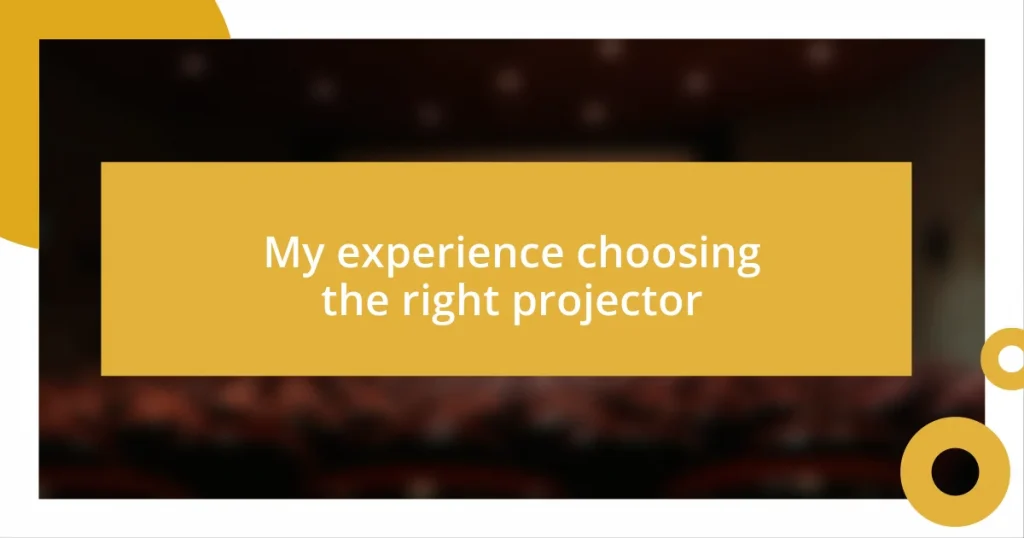Key takeaways:
- Understanding projector types (DLP, LCD, LCoS) is essential for maximizing purpose and environment usage.
- Assessing key specifications like brightness, resolution, and contrast ratio is crucial for achieving optimal image quality.
- Reading user reviews provides valuable insights into product performance and real-life experiences, aiding in informed decision-making.

Understanding different projector types
When I was choosing a projector, the variety of types overwhelmed me. There are three main kinds: DLP (Digital Light Processing), LCD (Liquid Crystal Display), and LCoS (Liquid Crystal on Silicon). Each has its own strengths, but understanding what you’ll mostly use the projector for is crucial; that can greatly influence your choice.
DLP projectors stood out to me because of their compact design and sharp images. I remember watching a movie with friends using a DLP, and we were all amazed at how vibrant the colors looked, even in moderately lit rooms. Have you ever noticed how some projectors can’t handle ambient light well? DLP really excels here, making it a solid pick for casual movie nights or presentations in less-than-dark environments.
On the other hand, I found LCD projectors had their charm, especially when it came to color accuracy and brightness. I once attended a lecture using an LCD projector, and it was an experience; the images were so clear and true to life. If you need something for still images and presentations where color integrity matters, I’d highly recommend considering this option. Does that resonate with how you envision using your projector?

Assessing brightness and resolution
When I took the plunge into choosing a projector, assessing brightness and resolution became my top priorities. Brightness is measured in lumens, and I realized that a higher lumen count translates to clearer images even in well-lit rooms. This became particularly important during a backyard movie night. I remember setting up my projector as dusk settled; the vibrant images danced on the screen, and the high brightness kept everyone glued to the story instead of squinting to see.
Here are a few tips that helped me during my selection process:
- For bright environments: Look for projectors with at least 2,500 lumens.
- For dark rooms: Around 1,500 lumens can often suffice.
- Resolution matters: Higher resolutions like 1080p or even 4K enhance clarity, especially for details in presentations or movies.
- Be mindful of the screen size: As the image gets larger, maintaining brightness and clarity becomes crucial.
Interestingly, I learned that resolution impacts not just the quality of an image, but also the depth of the viewing experience. One evening, while browsing online for projectors, I stumbled across a model promising full HD resolution. I hesitated, thinking about the extra cost, but I eventually decided to invest. That choice enriched the viewing experience immensely; every detail popped, and it transformed movie nights into something akin to a cinematic thrill! It was moments like these that made me realize the significance of getting my brightness and resolution right.

Evaluating projector features and specifications
When diving into the realm of projector features and specifications, I found it essential to focus on aspects such as contrast ratio and throw distance. The contrast ratio defines the difference between the darkest black and the brightest white the projector can produce, and I quickly realized that a higher contrast ratio makes for more dynamic visuals. I remember watching a documentary about the night sky; the starry visuals were incredibly rich and deep because of that contrast. Have you ever seen images wash out due to a low contrast ratio? It’s disappointing, especially when you’re trying to set the right mood.
I also learned that throw distance can significantly affect where you place your projector. A short throw projector can create a large image from just a few feet away, which became a game changer for my small living space. I fondly recall having a movie marathon with friends while we lounged comfortably on the couch, and there was no need for lengthy setup to create the ideal distance. This made me wonder – how often do we think about where our projector will sit before making a purchase? Finding that balance of distance and size allowed me to maximize my viewing experience.
To aid in your evaluation, I’ve compiled a comparison table that highlights important features and specifications to consider:
| Feature | Considerations |
|---|---|
| Brightness (Lumens) | Higher lumens are better for well-lit areas; lower for dark rooms. |
| Resolution | Higher resolutions (1080p or 4K) improve clarity, especially for detailed visuals. |
| Contrast Ratio | Higher ratios result in richer colors and deeper blacks. |
| Throw Distance | Short throw projectors save space; long throw requires a larger room. |

Comparing projector brands and models
When I began comparing projector brands and models, I quickly realized that not all brands are created equal. Some brands specialize in home theater projectors, while others focus on portable models. As I browsed through numerous options, I found myself gravitating towards brands recognized for their reliability and customer service. For example, I remember my friend raving about his Epson projector. He pointed out how easy it was to set up, which saved him so much time. That really resonated with me, since we all dread complicated installations, right?
Then there are the technical specifications that differ from model to model. Take brightness levels, for instance—the variance can be staggering! I distinctly recall encountering a model that boasted an impressive 4,000 lumens. I could almost feel the excitement surge through me, imagining how bright and sharp the images would appear during daylight movie sessions. But then I stumbled upon another model with a lower lumen count, sharing rave reviews for its color projection. It left me pondering—how much do those specifications really matter if user feedback comes from real experiences and not just numbers on a page?
Ultimately, it’s essential to read up on specific models and the experiences of others, much like I did. I spent hours watching comparison videos and reading reviews. One particularly helpful video highlighted a model that was both budget-friendly and packed with high-quality features. That insight was a game changer; it made me realize that even less expensive options could deliver fantastic performance. So, what’s more valuable, numbers or anecdotes? In my journey, I found that a blend of both helped me navigate the ocean of choices available.

Considering budget and price ranges
When considering my budget for a projector, I quickly realized that it significantly narrows my options. Initially, I set a low target, but I found myself drawn to projectors that were just slightly out of reach. Have you ever had that experience where you just know that spending a bit more could mean a noticeable increase in quality? It certainly sparked my motivation to reassess what I truly needed versus what I wanted.
As I explored different price ranges, I noticed a puzzling gap in features. For instance, I could spend less for a basic model or stretch my budget for something that offered 4K resolution and exceptional brightness. I recall having a lively discussion with a colleague who spent a bit more on her projector, saying it transformed family movie nights. This left me wondering—am I sacrificing enjoyment by staying too focused on my budget? Ultimately, that question nudged me toward a more balanced approach.
I learned the hard way that the cheapest option isn’t always the best investment. After purchasing a low-cost projector, I felt the sting of frustration when the image quality didn’t meet my expectations. The colors felt dull, and the brightness just didn’t cut it. It struck me that sometimes a slightly higher investment can save you from disappointment later on. So, where do you draw the line between affordability and quality? I’ve found that being willing to invest in the right projector can enhance not just your viewing experience, but also the memories you create while using it.

Reading user reviews and feedback
Reading user reviews and feedback became one of my favorite parts of the decision-making process. I vividly remember diving into forums and review sites, soaking up the praise and complaints that real users shared. It’s fascinating how a simple comment about ease of use or post-purchase support can influence your choice, isn’t it? Each review felt like a small window into someone else’s experience, which helped me feel more connected to my potential purchase.
One review stood out to me, describing how a user transformed their outdoor movie night experience with a specific projector they had purchased. Their excitement was palpable—mentioning the stunning image quality and how it brought friends and family together under the stars. I found myself envisioning my own gatherings, feeling inspired by the prospect of sharing those moments. It made me question: how could I not consider user feedback when it offered such rich insights about my own future experiences?
Navigating through the sea of opinions, I learned to discern authenticity in reviews. The ones that felt genuine, perhaps even flawed, resonated with me. I recall one testimonial that highlighted a minor inconvenience with setup but elaborated on the stunning picture quality that made it worth the trouble. It reinforced my belief that while no product is perfect, it’s the overall enjoyment that matters most. Isn’t it reassuring to know that you’re not alone in your choices and that countless others have been right where you are, sharing their stories?

Making the final decision
Making the final decision can feel like standing at the edge of a diving board—exciting but daunting. After sifting through options, I found myself staring at a shortlist of projectors, each with its pros and cons. It wasn’t just about the features anymore; it was about envisioning how each projector would fit into my life and the experiences I wanted to create—like making movie nights unforgettable.
As I pondered my choices, a sense of urgency crept in. I recalled the thrill of weekend gatherings where friends would flock to my place, eager to experience a cinematic escape. Could I live with a projector that fell short during those precious moments? I remember leaning towards one powerful model, and a sense of relief washed over me as I imagined the joy it would bring. Was it worth the extra expense? Absolutely, I thought—it meant quality time that every penny would justify.
Eventually, my decision became clearer as I listened to my gut feeling. I hesitated and then pulled the trigger on the projector that felt ‘right.’ That satisfaction of choosing based on a blend of research, personal needs, and emotional insight was immensely fulfilling. After all, isn’t making a choice that feels intuitively correct the crux of the whole process? I knew I couldn’t compromise on creating memories that would last a lifetime.















